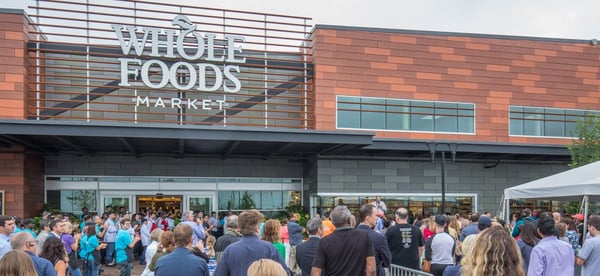There’s no question that Amazon has vaulted its way to the top of the retail world because, at its core, it’s not a retail business at all - it’s in the business of data.

And Amazon’s ability to push data projects and systems into production that evolve with customer needs and consider real-time inputs is their primary competitive advantage - not necessarily what they’re selling or how.
If you consider the use of data and data projects as the end goal, the recent acquisition of Whole Foods makes perfect sense; no one would dispute the fact that Amazon knows the online customer backwards and forwards, but when it comes to understanding the brick-and-mortar shopper, they lack insight. Amazon didn’t buy Whole Foods for the business - they bought it for the data.
The Brick-and-Mortar Advantage
Even with all of Amazon’s advancements in shipping, from complete mastery and optimization of supply chain analytics to predictive, anticipatory shipping, brick-and-mortar stores will always exist. Next-day and drone delivery further reduce the time from order to front door, but at the end of the day, customers still do use physical stores when they need an item fast.

Even with innovations in supply chain and shipping, physical stores will still be a necessary part of the retail picture.
Amazon’s competitors - like Target or Wal-Mart, to name a few - fell behind when Amazon first came on the scene, but in some ways, they now have an advantage in that they started as physical stores. So they have a view of both customers who buy online and those that shop in stores (or do a combination of the two).
While Amazon shot to the top by using big data to perfect and completely optimize their business in all ways, other retailers have caught up to some extent. And for a company in the business of data to miss a large swath of the customer view (the physical shopping experience) is a distinct disadvantage. Enter: Whole Foods.
Data for the Win-Win
Amazon (and its customers) will certainly win from gaining grocery spending data, which is valuable specifically because it is dominated by brick-and-mortar stores, an area where Amazon lacks. This is critical because even tech-era initiatives like Amazon Fresh or other grocery startups have largely been unsuccessful in drawing most customers away from their local grocery store. Whole Foods data for Amazon could change this game.
If a customer does most of his non-grocery item shopping on Amazon, given the popularity of Whole Foods (and the popular assumption that the Amazon customer largely overlaps with the Whole Foods customer), this $13.4 billion deal is the final piece of the puzzle. And this 360 degree customer view will set the stage for Amazon to build even more creative data products and innovations than ever before.

Amazon's acquisition of Whole Foods now gives them the data for a complete view of customers' shopping habits.
But another consideration is that this is almost certainly a win for Whole Foods customers as well. Whole Foods brings data for Amazon, which we’ve already established as a clear win. But Amazon can also bring its data innovation, scientists, labs, and creativity to Whole Foods, which ultimately can mean the next generation of grocery stores even for shoppers that aren’t interested in grocery delivery services. Think Amazon-like optimization of stocking using real-time data or predictive analytics to streamline the experience for shoppers and suppliers alike (and all while potentially helping to eliminate food waste, a massive problem in the United States today).
It's not JUST the data - it's the teams, too
Don’t forget that what will allow the data from Whole Foods to be even more valuable is that it now has Amazon’s data teams behind it - teams who have been able to, for many years, use real-time data to adapt quickly with customers, putting new models and data projects into production rapidly to really take advantage of the vast amount of data at their disposal.
This isn’t a small feat - having a collaborative, efficient data team is a key component to doing big things with big data. Without that piece of the puzzle, even with massive amounts of (complete) data, innovations couldn’t - and can’t - happen. It’s no secret that small, agile teams that collaborate and work together to make things happen quickly have been the key to success for Amazon. So it's not just the data that will bring Amazon a competitive advantage; it's the data combined with their structured and efficient data teams that will bring insights from that data into production.
More Data Isn’t Always Better, But Better Data Is
More data doesn’t always mean better data products, certainly. But many data scientists would agree that better data does. And that’s what the Whole Foods acquisition provides for Amazon: better, more robust data from which to build the next generation of retail innovations. I for one will be (im)patiently waiting to see what those innovations bring, both for my online Amazon and in-store Whole Foods shopping experiences.




